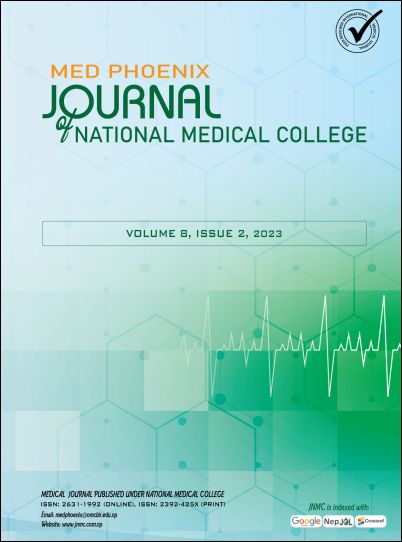A Comparative Study of Bupivacaine and Bupivacaine with Fentanyl for Subarachnoid Block
DOI:
https://doi.org/10.3126/medphoenix.v8i2.61822Keywords:
Bupivacaine, Fentanyl, Spinal AnaesthesiaAbstract
Introduction: Subarachnoid block (SAB) is the anesthesia of choice for lower abdominal and lower limb surgeries. The objective of the study was to evaluate and compare the onset, duration, recovery of neural blockade, hemodynamic changes and side effects of bupivacaine alone with fentanyl added to bupivacaine.
Materials and methods: This cross sectional comparative study was conducted in Department of Anaesthesia at National Medical College in 82 patients from April 2023 to September 2023 . Patients of either sex as per American Society of Anaesesiologists, Physical Status I-II between age 20- 60 years were randomly allocated to one of two groups of 41 each.
Results: This study showed that there was highly significant difference in the highest level of sensory block achieved between mthe two groups (p < 0.001 ) and motor blockade. Most of patients receiving bupivacaine alone (Group B) had achieved T6 dermatomal sensory level block and Bromage score of 4, while patients receiving fentanyl with bupivacaine (Group F) achieved T8 and also Bromage score of 3 respectively. The mean duration for highest sensory level in group F and group B was 7.76 and 9.66 minutes, respectively. The mean duration for 2 segment regression in group F and group B was 95.28 and 67.24 minutes respectively. Hypotension was significantly high in Group B.
Conclusion: Fentanyl added to bupivacaine has an earlier onset of action, prolonged sensory analgesia but earlier motor recovery compared to bupivacaine alone but a comparatively lower sensory dermatomal level without complete motor blockade, adequate for surgical procedures.
Downloads
Downloads
Published
How to Cite
Issue
Section
License
Copyright (c) 2023 Med Phoenix

This work is licensed under a Creative Commons Attribution 4.0 International License.
Copyright on any research article is transferred in full to MED PHOENIX upon publication. The copyright transfer includes the right to reproduce and distribute the article in any form of reproduction (printing, electronic media or any other form).
© MEDPHOENIX
![]()
Articles in the MED PHOENIX are Open Access articles published under the Creative Commons CC BY License (https://creativecommons.org/licenses/by/4.0/). This license permits use, distribution and reproduction in any medium, provided the original work is properly cited.




